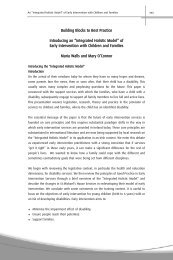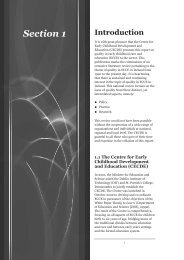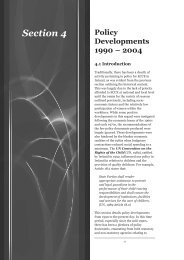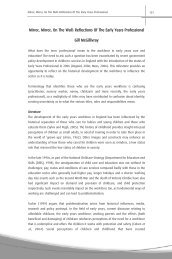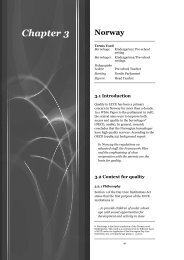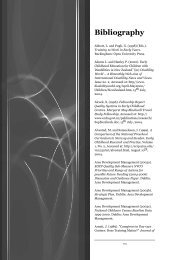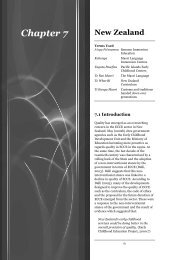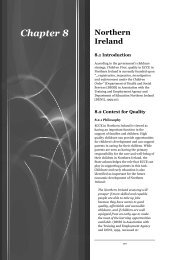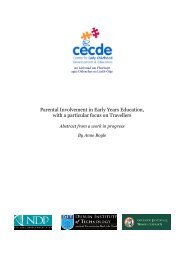Sweden - Centre for Early Childhood Development & Education
Sweden - Centre for Early Childhood Development & Education
Sweden - Centre for Early Childhood Development & Education
You also want an ePaper? Increase the reach of your titles
YUMPU automatically turns print PDFs into web optimized ePapers that Google loves.
Chapter 4<strong>Sweden</strong>Most notable when looking at the issue ofquality in <strong>Sweden</strong> is the lack of centraliseddefinitions and the absence of mechanisms<strong>for</strong> monitoring quality at a national level.Responsibility <strong>for</strong> quality assurance lieswith the local authorities and individualsettings (Mooney et al., 2003). Thegovernment once regulated ECCE servicesin a strict manner in <strong>Sweden</strong> and raised thestandards and the expectations of serviceusers nationally. According to Mooney etal. (2003:12):Once services are generally of a highstandard and communities have cometo expect this level of service,governments appear more able todevolve responsibility <strong>for</strong> qualityassurance and have less need of acentralised approach.4.2 Context <strong>for</strong> Quality4.2.1 PhilosophyECCE in <strong>Sweden</strong> is linked to a societalvision <strong>for</strong> children in the future. Childcarein <strong>Sweden</strong> has two primary aims; tosupport and encourage children'sdevelopment and learning and to enableparents to combine their childcareresponsibilities with education oremployment (OECD, 2001). ECCE has hadhigh priority <strong>for</strong> several decades and is acentral component of family policy in<strong>Sweden</strong> (Kamerman, 2001). Lohmander(2002) describes childcare as a cornerstoneof the Swedish publicly funded socialwelfare system. There is a strong belief thatchildhood should be valued in and of itself(Mooney et al., 2003) and the provision ofhigh quality ECCE service is seen as animportant task <strong>for</strong> society (Lohmander,2002). Pre-school provision is alsoidentified as the first step in the life-longlearning process (Prieto et al., 2002) andthe need <strong>for</strong> a smooth transition from preschoolto school has been a concern ofpolicy makers in <strong>Sweden</strong> <strong>for</strong> many years. In<strong>Sweden</strong>, special emphasis is placed on well-educated staff, size and composition ofgroups and the suitability of the premisesand "…the declared goal is childcarewholly free of charge." (cited in Pestoff andStrandbrink, 2002:16)Mayall (1996:56) notes there has been achange in the conceptualisation of childrenin <strong>Sweden</strong> in recent years as a distinctsocial group, with a shared responsibility<strong>for</strong> them between parents and the State4.2.2 PolicyIn <strong>Sweden</strong>, the locus of policymakingregarding ECCE is both national and local(Kamerman, 2000). While overall nationalgoals and guidelines <strong>for</strong> ECCE are set atnational level (these goals are set out in the1998 School Act, the curriculum and otherordinances), the municipality decides howthe goals should be made concrete (OECD,1999a). The National Agency <strong>for</strong> <strong>Education</strong>monitors the fulfilment of these goals.Municipalities are charged with providingsufficient numbers of pre-school andleisure time places, with monitoring thequality of ECCE services and with providingsufficient resources. Following thedecentralisation of responsibility <strong>for</strong> ECCE,most local authorities establishedcommittees to deal with issues of relevanceto children and adolescents (Lindon,2000). Teachers, heads of ECCE centresand of out of school provision arerepresented on these committees.In 1996, responsibility <strong>for</strong> public childcarewas transferred from the Ministry of Healthand Social Affairs to the Ministry of<strong>Education</strong> and Science. This representsrecognition of the educational benefits ofECCE services and a desire to facilitate theintegration of the childcare and the <strong>for</strong>maleducation system (OECD, 1999b).4.2.3 FundingThe main source of subsidy <strong>for</strong> parentalchildcare costs is supply funding(Candappa et al., 2003) in the <strong>for</strong>m of51



